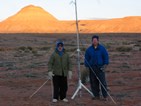Radio Telescope In Desert Dead Zone To Aid In Dark Energy Research

Can you hear me now?
Television commercials portray nightmarish "dead zones" where cell phone signals vanish.
Places, they say, to avoid.
Unless you are Fermilab engineers Ralph Pasquinelli and Dave McGinnis. The duo, along with Carnegie Mellon University's Kevin Bandura, a Moroccan team from Al Akhawayn University and a French team from Saclay and Orsay, traveled to Morocco last month to find a home uncluttered by radio wave chatter for the 21 cm project.
The proposed 500 MHz to 1000 MHz radio telescope will make a 3-D map of the universe using radio frequency waves, which will help astronomers understand the mysterious dark energy.
"Early on, there was a stage in the expanding universe where variations in density were caused by cosmic sound waves, called baryon acoustic oscillations, ricocheting through the universe. Dark energy affected how the cosmic sound waves travelled. As the universe expanded and cooled, these density variations froze out, or stopped changing. By measuring the density fluctuations of the universe in 3D we can hope to understand more about dark energy," McGinnis said.
Cell phones, radios and TVs use the same radio frequency band, which can drown out the tiny radio signal coming from outer space.
"We needed to get away from man-made items, to see whether the site would be quiet enough," Pasquinelli said.
The sensitive Fermilab test equipment, which survived Moroccan sand, wind, rain, snow and airports, did detect some cell phone signals, but at a level a million times smaller than what is seen around Fermilab. The team also measured large swaths of the radio frequency spectrum and found no interfering radio signals, which made Morocco's remote desert one of the quietest of the potential experiment sites scouted, including those in South Africa, Australia and Canada.
The collaborators hope to get funding for the estimated $20-25 million project from the Arab states. The collaboration plans to keep the cost down by using inexpensive cell phone technology for the receiver amplifiers and signal processing electronics.
The antenna measures about 150 meters by 150 meters and will feed more than 2,000 extremely sensitive radio receivers. Even with such a large, sensitive telescope, the telescope will have to integrate data for years to measure the tiny radio signal with enough precision.
SOURCE: Fermi National Accelerator Laboratory
